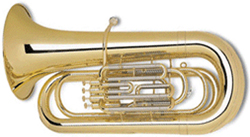The Bach 1109 Tuba comes in the key of BBb, .728" bore, 17-1/2" yellow brass upright bell, red brass mouthpipe, four valves, nickel-plated nickel silver pistons with bottom-spring action, bronze valve springs, pin-type plastic valve guides, anodized valve stems, one-piece valve casing, genuine Vincent Bach mouthpiece, formed case, clear epoxy lacquer finish.
BACH HISTORY
Vincent Bach, in combining his unique talents as both a musician and an engineer, created brass instruments which remain the sound choice of artists worldwide. Born Vincent Schrotenbach in Vienna during 1890, initial musical training was received on the violin. However, young Vincent preferred the majestic sounds of the trumpet and eventually switched. Also displaying an aptitude in science, Vincent graduated from the Maschinenbauschule with an engineering degree. His heart remained in music, leaving an engineering career for an uncertain future in music. Success soon followed as he toured throughout Europe, adopting the stage name of Vincent Bach while in England.
Through a series of events, Vincent arrived in New York City during World War I with $5.00 in his pockets. Initial vaudeville theater work was secured through connections with Oscar and Arthur Hammerstein. A letter in 1914 to conductor Karl Muck resulted in an audition and a position with the Boston Symphony. The following season Vincent served as first trumpet in the Metropolitan Opera House opera and ballet orchestras, performing in the American premiere of Stravinsky's Petroushka and Firebird.
While on tour in Pittsburgh, a repairman convinced Vincent that he could improve his mouthpiece. After ruining the mouthpiece, Vincent experienced difficulty in finding a suitable replacement. He now recognized the need by brass players for high-quality mouthpieces. Initially Vincent remodeled old mouthpieces and made new ones in the back of the Selmer Music Store in New York City.
In 1918 he invested $300 for a foot-operated lathe and office at 11 East 14th Street and set about the business of making mouthpieces, continuing part-time at the Rivoli Theater. Offers of $50 were received for Bach mouthpieces - mouthpieces at the time sold for $1.50. From that point on the business grew rapidly. The first Bach ads appeared in The Metronome during the early 1920s. Not one to be discouraged by an initial slow sales response, Vincent changed the ad headline to read “How To Become A Wizard On The Cornet Without Practicing,” to which he received over $500 in orders during the first seven days.
The first trumpets were produced in 1924. Musicians frequently commented “This is a real 'Stradivarius' of a trumpet,” hence the brand name Bach Stradivarius. Trombones followed in 1928, a risky time for Vincent to expand with the stock market crash, bank failures, and the ensuing Great Depression.
However, a strong demand remained for Bach instruments and mouthpieces due to their superior design, high quality, and prompt service.
During his career Vincent served as president of the National Association of Band Instrument Manufacturers (NABIM). In 1961, at the age of 71, the company was placed for sale. Despite receiving twelve other offers for the company, some with even higher bids, Vincent chose The Selmer Company. Having developed a close relationship with Selmer and George Bundy over the years, he felt that Selmer would best expand upon his foundations. All tooling and machinery was moved to Selmer's operations in Elkhart, Indiana, with Vincent assisting in the training. Original designs and blue prints have been carefully preserved in manufacturing the sound choice of professionals.
Bach 1109

